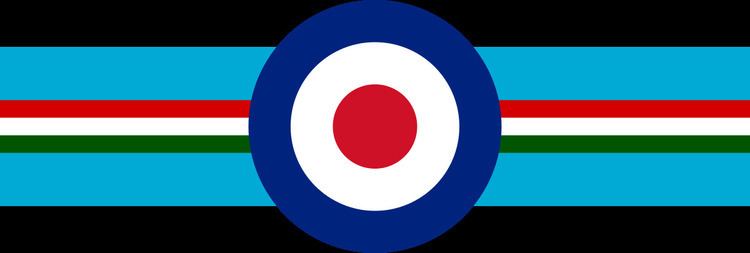 | ||
Active 1 September 1915 - 1 August 194711 February 1949 - 16 September 195114 June 1952 - 30 December 19601 September 1961 - 13 February 19701 December 1970 - 31 July 19921 September 1992 - 31 March 2010 Motto(s) Latin: Facta non verba("Deeds not Words") Battle honours Western Front 1916–1918Somme 1916ArrasYpres 1917Somme 1918LysHindenburg LineMahsud 1919–1920Waziristan 1919–1925Mohmand 1927North-West Frontier 1930–1931Mohmand 1933North-West Frontier 1935–1939North Burma 1943–1944Arakan Campaign 1943–1944Manipur 1944Burma 1944–1945Gulf 1991 Squadron Badge heraldry In front of the rising sun, an eagle, wings elevated and perched on a sword.The rising sun is intended to commemorate the unit's long association with the East. The eagle is perched on 'Talwar' indicative of the Squadron's work with the Army in India. | ||
No. 20 (R) Squadron of the Royal Air Force was from September 1992 until March 2010, the OCU (Operational Conversion Unit) for the BAE Harrier GR9, and T12, operating from RAF Wittering. A reserve squadron, it could be called upon for combat duties if necessary.
Contents
World War I
The squadron was formed on 1 September 1915, as a fighter-reconnaissance unit of the Royal Flying Corps, and became arguably the highest scoring and possibly most decorated British squadron on the Western Front with 613 combat victories, a posthumous Victoria Cross won by Thomas Mottershead, four Distinguished Conduct Medals, and over sixty Military Crosses and Military Medals awarded to its members. Its ranks included over forty flying aces. The squadron transferred from the Royal Flying Corps to the newly formed Royal Air Force in April 1918.
Post World War I, unlike most of its contemporaries, the squadron was not disbanded and was transferred in Jun 1919 to the North-West Frontier Province, India for policing duties, in the Army Co-operation role, equipped with Bristol Fighters, then Wapitis and Audaxes for the whole of the inter-war period.
World War II
At the outbreak of World War II, the squadron was still equipped with Audaxes, which were replaced with Lysanders in December 1941, re-equipping with Hurricanes in March 1943. During the Second World War the squadron's Hawker Hurricane IIDs and IVs saw action against the Japanese.
After the war, the squadron re-equipped with Spitfires in September 1945, and Tempest FBIIs in May 1946, retaining these until it disbanded on 1 August 1947, whilst based in India.
Cold War
20 Squadron reformed at RAF Llanbedr on 11 February 1949 as an Anti-Aircraft Co-operation (AAC) squadron, moving to RAF Valley on 19 July 1949, equipped with miscellaneous aircraft. The squadron disbanded at Valley on 16 September 1951.
In June 1952 the squadron reformed at RAF Jever, Germany, operating the de Havilland Vampire and moved to RAF Oldenburg a month later. The Vampires were replaced in 1953 by Canadair Sabres which were themselves replaced with Hawker Hunters. The squadron was disbanded in 1960, only to be reformed again at RAF Tengah, Singapore, again operating Hunters. Following the withdrawal of the RAF from the Far East the squadron disbanded in 1970.
20 Squadron reformed again in late 1970 at RAF Wildenrath, Germany, operating the Hawker Siddeley Harrier.
In 1977 at RAF Bruggen the squadron re-equipped with twelve SEPECAT Jaguar strike aircraft, various weapons for the squadron's conventional strike role of support for ground forces in repelling a Soviet attack in Europe, and eight WE.177 tactical nuclear bombs for use if a conflict escalated to the nuclear phase. The apparent mismatch between eight nuclear bombs and twelve aircraft was because RAF staff planners expected up to one third attrition in the conventional phase, with sufficient aircraft held back in reserve to deliver the full stock of nuclear weapons to targets beyond the forward edge of the battlefield, deep into the enemy's rear areas. The squadron was assigned to SACEUR for operational and targeting purposes, although political control over release of the British-owned WE.177 weapons was retained by the British government in London.
The squadron re-equipped again with twelve Tornado GR1 aircraft at RAF Laarbruch in 1984, while its stock of WE.177 weapons increased to eighteen because of the Tornado's greater capacity. The squadron's war-role and assignment to SACEUR remained unchanged.
Operational Conversion Unit
In May 1992 the Options for Change defence review called for the disbanding of 20 Squadron as a front line unit, and it disbanded on 31 July 1992. On 1 September 1992 the squadron numberplate was assigned to the Harrier Operational Conversion Unit at RAF Wittering as No. 20 (Reserve) Squadron.
With the formation of Joint Force Harrier and the decision to withdraw the FAA's Sea Harriers, the personnel of the RAF's No. 1 and 4 Squadrons, and the RN's 800 Naval Air Squadron and 801 Naval Air Squadron, later known as Naval Strike Wing, were absorbed with 20(R) Squadron into a joint RAF/RN unit, manned 50/50 by each service.
On 9 February 2009, a 20(R) Squadron Harrier T12, ZH656, crashed at RAF Akrotiri while on training operations there. Both crew ejected safely and were treated in hospital for minor injuries.
As a result of 2010 defence cuts, 20 Squadron disbanded on 31 March 2010, with its tasks taken over by the retitled 4 (Reserve) Squadron.
